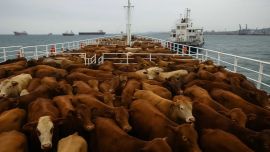Decades ago, well before I could visit Patagonia’s great backwaters, I had the pleasure of reading Gerald Durrell’s travelogue The Whispering Land, whose description of remote Puerto Deseado instantly aroused my interest. Finally, in early 1995, I was able to take the paved detour off southbound Ruta 3, in northern Santa Cruz province, and see the destination that Durrell had described in 1958 as the “set for a bad Hollywood cowboy film.”
Even given the abundant penguins that drew Durrell there, his description wasn’t quite fair, as Deseado has some distinctive architecture. When I saw the town for the first time, I’d spent the previous summer researching a guidebook to the Rocky Mountain states, and I concluded that this part of Santa Cruz province felt like “Wyoming-by-the-Sea, with a turn-of-the-century train station that could have been plucked off the Great Plains.” It had a longer indigenous history, of course, and Darwin even put in a cameo where, observing ruins of a Spanish settlement, he concluded that: “The result of all the attempts to colonise this side of America south of 41° has been miserable.
It’s surprising that Darwin didn’t describe Deseado’s fauna in greater detail — opposite the town there are colonies of Magellanic penguins and various cormorants at nearby Isla Chaffers and Isla de los Pájaros, which I saw from a rigid inflatable with the local operator Darwin Expediciones. That’s where I went on my first visit here — there are daily excursions in summer — but more recently I had a chance to see the oceanic island of Isla Pingüinos. That demands greater flexibility, as excursions take place about three times weekly.
Pingüinos, now part of a national marine park, lies about 25 km southeast of Deseado. Because reaching it involves crossing the open ocean, launches leave early in the morning, when the powerful winds tend to diminish. Approaching the island, we sight families of southern sea lions, and I still wonder why Spanishspeakers refer to them as lobos marinos (sea wolves) when the bulls have such a conspicuously leonine mane. After the launch docks in a sheltered cove on the west, we’re able to walk to the antique lighthouse (now solar-powered), where some Magellanic penguins have supplanted human attendants.
The treat, though, is the side of the island that faces the open Atlantic, where the waves toss crested rockhopper penguins — the northernmost breeding population of this colourful species — onto the rocks, whence they scramble to nesting sites above the breakers. The rockies are raucously amusing, though the ammonia odour of their excrement discourages some visitors from staying there for long.
On the island’s north side there are elephant seals, which we see only from a distance but, en route back to the mainland, we stop to observe an open-ocean feeding frenzy where cormorants, gulls, skuas, and even majestic black-browed albatrosses have found a school of fish. A pod of Commerson’s dolphins also take their share, before we resume the voyage and finally dock at Darwin’s headquarters on the quay.
Back in town, a walk down the main drag leads to the defunct railroad’s Estación del Ferrocarril Patagónico (1909), an imposing structure that’s now a museum. On a small plaza, the Vagón Histórico railcar served as a mobile headquarters for Colonel Héctor Benigno Varela’s violent 1921 campaign against striking farm workers, dramatised in Osvaldo Bayer’s film La Patagonia Rebelde. Other distinguished buildings include the Sociedad Española (1915), the Italianate Compañía Argentina del Sud (now a supermarket, 1919), and the Banco de la Nación (1922).
While it’s not exactly a beach resort, Deseado can boast of Balneario Las Piletas where, on warm summer days, bathers can soak and swim in volcanic pools when the tide recedes. It’s about four kilometres northeast of town; in the other direction, the Gruta de Lourdes is a shrine in a wash that, in a rare rain, feature ephemeral waterfalls. With all these sights, Deseado easily merits a three-day stopover.
As a wildlife site Bahía Bustamante, about 165km northeast of Comodoro via Ruta 3 and a gravel spur, is a different species of destination. Its fauna overlap with those of Deseado, but it owes its existence — and still a large part of its contemporary economy — to the abundance of kelp that made it a company town in the early 1950s. In fact, all the streets, such as Avenida Gracilaria, bear the names of kelp species that are harvested, baled and hauled to Gaiman for processing as agricultural compost, cosmetics, and food additives.
There’s a self-guided history tour — you can still see the “seaweed sheds” in action — but the population is a fraction of what it once was. Several of the administration buildings have been recycled as accommodations and a lodge/restaurant for those who come to enjoy the offshore wildlife — cormorants, dolphin gulls, giant petrels, Magellanic penguins, steamer ducks, sea lions, snowy sheathbills — and more inland bichos such as caranchos (crested caracaras), guanacos, and rheas. Personally, though, I found the highlight to be the extensive petrified forest in the badlands behind the settlement.
Like Puerto Deseado, Bustamante is home to a coastal national park, the Parque Interjurisdiccional Marino Costero Patagonia Austral. Bustamante may be more exclusive in terms of its clientele but, thanks to their relative isolation — the oil town of Comodoro Rivadavia is the closest major airport — neither is for the masses. Because of that isolation, neither is ever likely to be Mar del Plata or Pinamar, and that’s a good thing.
WHERE TO STAY AND VISIT
About 300 km southeast of Comodoro Rivadavia via the longitudinal Ruta 3 and the Ruta 281 spur, Puerto Deseado’s attractions are greater than its services.
The best accommodations are at Hotel Los Acantilados (upstairs rooms are better) and Hotel Isla Chaffers, both most easily contacted through Turismo Puerto Deseado (www.turismo.deseado.gob.ar). For seafood, there’s Puerto Cristal, just across the road from Darwin Expediciones (www.darwinexpeditions.com), which has the most reliable tours.
About 200 km northwest of Comodoro, Bahía Bustamante (www.bahiabustamante.com) is a destination in itself, with quality accommodations in recycled buildings.
Those include four superior sea cabins with full board except for drinks, and a capacity for four people; two simpler standard sea cabins, also with full board and capacity for four; and five steppe cabins, with cooking facilities (meals additional). In the main lodge, the dinner menu offers lamb and fish as well, with seaweed-based condiments, and produce from their own gardens.
There’s also a bar and a library, and a display on the town’s history.
























Comments